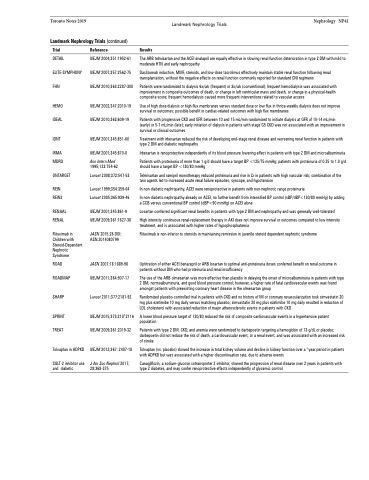Page 741 - TNFlipTest
P. 741
Toronto Notes 2019
Landmark Nephrology Trials (continued)
Landmark Nephrology Trials Nephrology NP41 The ARB telmisartan and the ACEI enalapril are equally effective in slowing renal function deterioration in type 2 DM with mild to
moderate HTN and early nephropathy
Daclizumab induction, MMF, steroids, and low-dose tacrolimus effectively maintain stable renal function following renal transplantation, without the negative effects on renal function commonly reported for standard CNI regimens
Patients were randomized to dialysis 6x/wk (frequent) or 3x/wk (conventional); frequent hemodialysis was associated with improvement in composite outcomes of death, or change in left ventricular mass and death, or change in a physical-health composite score; frequent hemodialysis caused more frequent interventions related to vascular access
Use of high dose dialysis or high flux membranes versus standard dose or low flux in thrice-weekly dialysis does not improve survival or outcomes; possible benefit in cardiac-related outcomes with high flux membranes
Patients with progressive CKD and GFR between 10 and 15 mL/min randomized to initiate dialysis at GFR of 10-14 mL/min (early) or 5-7 mL/min (late); early initiation of dialysis in patients with stage G5 CKD was not associated with an improvement in survival or clinical outcomes
Treatment with irbesartan reduced the risk of developing end-stage renal disease and worsening renal function in patients with type 2 DM and diabetic nephropathy
Irbesartan is renoprotective independently of its blood pressure lowering effect in patients with type 2 DM and microalbuminuria
Patients with proteinuria of more than 1 g/d should have a target BP <125/75 mmHg; patients with proteinuria of 0.25 to 1.0 g/d should have a target BP <130/80 mmHg
Telmisartan and ramipril monotherapy reduced proteinuria and rise in Cr in patients with high vascular risk; combination of the two agents led to increased acute renal failure episodes, syncope, and hypotension
In non-diabetic nephropathy, ACEI were renoprotective in patients with non-nephrotic range proteinuria
In non-diabetic nephropathy already on ACEI, no further benefit from intensified BP control (sBP/dBP<130/80 mmHg) by adding a CCB versus conventional BP control (dBP<90 mmHg) on ACEI alone
Losartan conferred significant renal benefits in patients with type 2 DM and nephropathy and was generally well-tolerated
High intensity continuous renal-replacement therapy in AKI does not improve survival or outcomes compared to low intensity treatment, and is associated with higher rates of hypophosphatemia
Rituximab is non-inferior to steroids in maintaining remission in juvenile steroid dependent nephrotic syndrome
Uptitration of either ACEI benazepril or ARB losartan to optimal anti-proteinuria doses conferred benefit on renal outcome in patients without DM who had proteinuria and renal insufficiency
The use of the ARB olmesartan was more effective than placebo in delaying the onset of microalbuminuria in patients with type 2 DM, normoalbuminuria, and good blood pressure control; however, a higher rate of fatal cardiovascular events was found amongst patients with preexisting coronary heart disease in the olmesartan group
Randomized placebo-controlled trial in patients with CKD and no history of MI or coronary revascularization took simvastatin 20 mg plus ezetimibe 10 mg daily versus matching placebo; simvastatin 20 mg plus ezetimibe 10 mg daily resulted in reduction of LDL cholesterol with associated reduction of major atherosclerotic events in patients with CKD
A lower blood pressure target of 120/80 reduced the risk of composite cardiovascular events in a hypertensive patient population
Patients with type 2 DM, CKD, and anemia were randomized to darbepoetin targeting a hemoglobin of 13 g/dL or placebo; darbepoetin did not reduce the risk of death, a cardiovascular event, or a renal event, and was associated with an increased risk of stroke
Tolvaptan (vs. placebo) slowed the increase in total kidney volume and decline in kidney function over a 3-year period in patients with ADPKD but was associated with a higher discontinuation rate, due to adverse events
Canagliflozin, a sodium-glucose cotransporter 2 inhibitor, slowed the progression of renal disease over 2 years in patients with type 2 diabetes, and may confer renoprotective effects independently of glycemic control
Trial
DETAIL ELITE-SYMPHONY FHN
HEMO IDEAL
IDNT
IRMA MDRD
ONTARGET
REIN REIN2
RENAAL RENAL
Rituximab in Children with Steroid-Dependent Nephrotic Syndrome
ROAD ROADMAP
SHARP
SPRINT TREAT
Tolvaptan in ADPKD
SGLT-2 inhibitor use and diabetic
Reference
NEJM 2004;351:1952-61 NEJM 2007;357:2562-75 NEJM 2010;363:2287-300
NEJM 2002;347:2010-19 NEJM 2010;363:609-19
NEJM 2001;345:851-60 NEJM 2001;345:870-8
Ann Intern Med
1995;123:754-62 Lancet 2008;372:547-53
Lancet 1999;354:359-64 Lancet 2005;365:939-46
NEJM 2001;345:861-9 NEJM 2009;361:1627-38
JASN 2015;26 DOI: ASN.2014080799
JASN 2007;18:1889-98 NEJM 2011;364:907-17
Lancet 2011;377:2181-92 NEJM 2015;373:2103-2116
NEJM 2009;361:2019-32 NEJM 2012;367: 2407-18
J Am Soc Nephrol 2017; 28:368-375
Results


